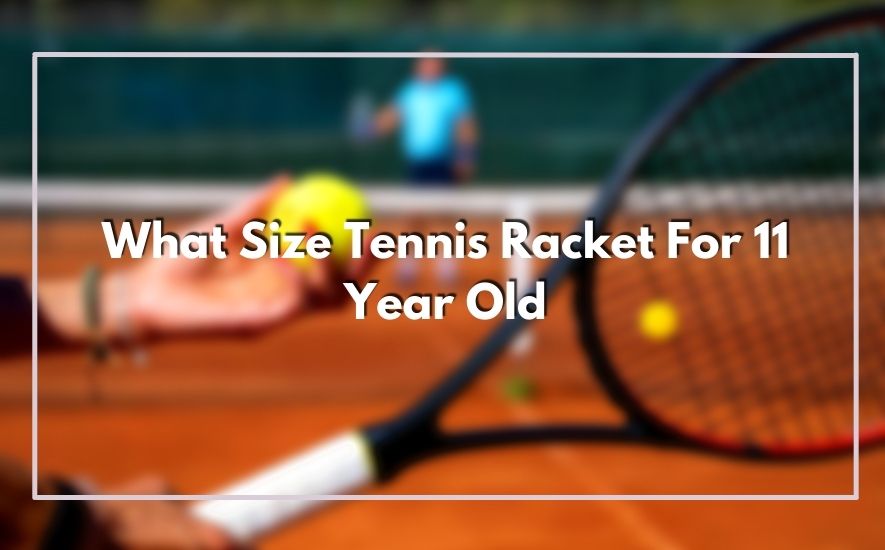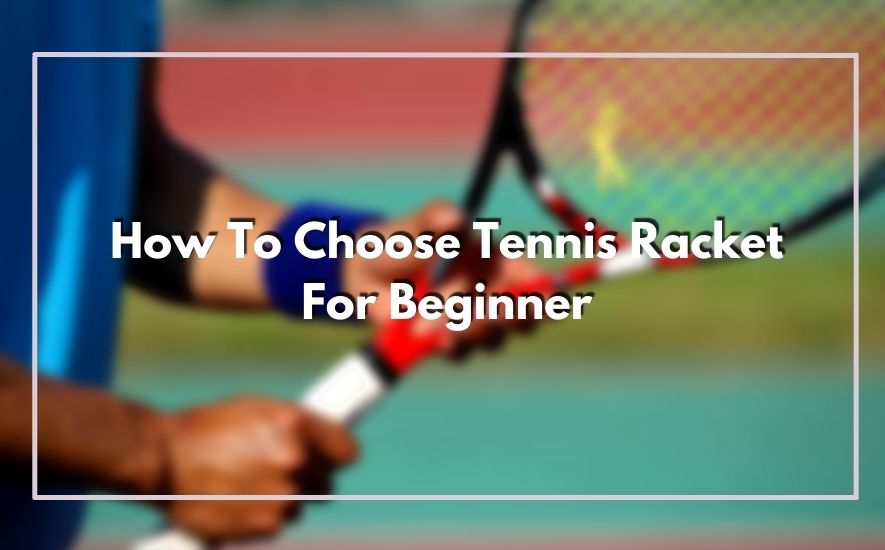Are you searching for the perfect tennis racket size for your 11-year-old? Selecting the right racket is crucial to helping young players develop their skills and enjoy the game fully.
What Size Tennis Racket For 11 Year Old? When finding the right tennis racket size for an 11-year-old, it’s important to consider their height and strength. Generally, a racket with a grip size between 4 and 4 1/8 inches is suitable for children of this age group. Additionally, the length of the racket should typically be around 25 to 26 inches.
In this guide, we will explore the ideal size for a tennis racket for an 11-year-old, considering their age, height, and physical abilities. By understanding the key factors contributing to a well-fitted racket, you can ensure your child has a comfortable and efficient playing experience on the court. Let’s dive in!
Table of Contents
Factors to Consider When Buying a Tennis Racket for an 11-Year-Old
Choosing the right tennis racket for an 11-year-old can greatly enhance their game and ensure a positive experience on the court. When making this purchase, several factors should be considered to ensure the racket is suitable for their age, size, skill level, and playing style.
Size and Weight:
One of the primary considerations when selecting a tennis racket for an 11-year-old is the size and weight of the racket. Choosing a racket that matches the child’s physique and strength is crucial.
A too-heavy racket can hinder their swings, leading to fatigue and potential injuries. Opting for a lightweight racket will allow the child to maneuver it more easily and generate proper racket head speed, essential for effective shots.
Grip Size:
The grip size of the racket is another vital factor to consider. A proper grip size ensures the player can comfortably hold the racket and maintain control during play. If the grip is too small, the child’s hand may strain and tire quickly.
Conversely, an oversized grip can lead to a lack of control and hinder their ability to execute strokes accurately. It is advisable to have the young player’s hand measured to determine the appropriate grip size for their age and hand dimensions.
Racket Length:
The length of the tennis racket is crucial to consider when buying one for an 11-year-old. Rackets come in various lengths, and choosing the right one is vital for their technique and swing development.
Typically, rackets for children in this age group range from 23 to 26 inches long. A shorter racket allows for better control and maneuverability, aiding the young player’s skill progression.
Head Size:
The head size of the racket directly affects the power and forgiveness of shots. For an 11-year-old, choosing a racket with a slightly larger head size is recommended.
A larger head provides a more significant sweet spot, which increases the chances of hitting the ball cleanly and with power. This feature helps build confidence and encourages a positive experience on the court.
Material and Construction:
Consider the material and construction of the racket. Graphite and aluminum rackets are popular for young players due to their lightweight nature and durability.
These materials balance power and control, allowing the child to improve their skills while enjoying the game. It is important to look for a well-built racket that can withstand the rigors of regular use.
Balance and Swing Weight:
The balance and swing weight of the racket also play a role in its suitability for an 11-year-old. A balanced racket, where the weight is evenly distributed throughout the frame, provides stability and control.
Additionally, a slightly head-light racket can help improve maneuverability. As for swing weight, a moderate to light swing weight allows for easier racket acceleration, enabling the child to generate more power and spin in their shots.
Table Chart of Tennis Racket Sizes by Child Age
The appropriate racket size ensures better control, maneuverability, and power, allowing players to maximize their potential.
It’s important to consider age and physical attributes when selecting a tennis racket, as these factors can influence the ideal size for optimal play.
Table Chart of Tennis Racket Sizes by Age:
| Age Group | Racket Size (Length) |
|---|---|
| 4-5 years | 19 inches |
| 6-8 years | 21-23 inches |
| 9-10 years | 23-25 inches |
| 10-12 years | 25-26 inches |
| 12-14 years | 26-27 inches |
| 14 years & up | 27-29 inches |
Remember that the above chart provides general guidelines, and individual players may have specific preferences or physical attributes that influence their racket choice.
It’s recommended to consult with a tennis coach or a sports equipment specialist for personalized advice based on the player’s skill level, physical development, and playing style.
Finding the right racket size can enhance a player’s comfort, technique, and overall game enjoyment.
How Do I Care for My Child’s Tennis Racket to Make it Last Longer
Taking proper care of your child’s tennis racket is crucial to ensure its longevity and optimal performance on the court. By following a few simple steps, you can help maintain your child’s racket in excellent condition.
Cleaning the Racket:
Regular cleaning of the tennis racket is essential to remove dirt, sweat, and grime that can accumulate on the strings and frame. Use a soft, damp cloth to wipe down the racket after each use.
Pay extra attention to the grip and strings, as they are more susceptible to dirt buildup. Avoid using harsh chemicals or abrasive cleaners, as they can damage the racket’s materials.
String Care:
The strings are the heart of a tennis racket, and proper maintenance can significantly extend their lifespan. After each game or practice session, inspect the strings for signs of wear or fraying.
If you notice any loose or broken strings, consider having them re-strung by a professional. It’s also a good idea to regularly adjust the tension of the strings to ensure optimal performance.
Storage:
Proper storage is crucial to protect the tennis racket from damage when not in use. Store the racket in a cool, dry place away from direct sunlight, extreme temperatures, and humidity.
Avoid placing heavy objects on top of the racket, as this can lead to warping or deformation of the frame. It’s advisable to use a racket cover or a specialized tennis bag to provide additional protection during transportation.
Grip Maintenance:
The grip is an important part of the tennis racket, providing control and comfort during play. Over time, the grip may become worn or lose its tackiness.
To maintain a good grip, periodically replace the overgrip or apply grip enhancers. Additionally, ensure that your child’s hands are clean and dry before gripping the racket, as sweat and dirt can cause the grip to deteriorate faster.
Avoid Excessive Force:
Please encourage your child to use the racket within its recommended limits. Excessive force, such as hitting the ground or forcefully banging the racket against hard surfaces, can lead to cracks or fractures in the frame.
Teach your child proper technique and discourage any behavior that may result in unnecessary stress on the racket.
Regular Inspections:
Regularly inspect the racket for any signs of damage, including cracks, loose strings, or worn grip.
Addressing these issues promptly can prevent further damage and increase the racket’s lifespan. If you notice any significant damage, consult a professional or contact the racket manufacturer for appropriate repair or replacement options.
Why Should You Buy a Tennis Racket for an 11-Year-Old Child
Buying a tennis racket for your 11-year-old child can be a wise decision that can pave the way for their physical, mental, and social development. Tennis is a sport that offers numerous benefits to children, and owning a suitable racket plays a vital role in their progress.
Encourages Physical Activity:
Physical activities are crucial for children’s overall health and well-being. Tennis, a dynamic and fast-paced sport, provides an excellent opportunity for children to stay active and develop their physical fitness.
Buying a tennis racket for your 11-year-old child will encourage them to participate in this enjoyable sport, promoting regular exercise and helping them build strength, agility, and coordination.
Enhances Motor Skills:
Tennis requires fine motor skills, such as hand-eye coordination and precise movements. Using a tennis racket will challenge your child’s coordination and improve their ability to track the ball, swing accurately, and control their shots.
By regularly practicing with a racket, your child can enhance their motor skills and develop better control over their body movements.
Fosters Mental Development:
Playing tennis involves strategy, decision-making, and quick thinking. By owning a tennis racket, your child can actively engage in the game’s mental aspects, which can enhance their cognitive abilities.
They will learn to anticipate the ball’s trajectory, make split-second decisions, and adjust their movements accordingly. These mental challenges will improve their problem-solving skills, focus, concentration, and overall cognitive development.
Promotes Social Interaction:
Tennis is a social sport that allows children to interact with their peers, coaches, and opponents. By owning a tennis racket, your 11-year-old child can participate in tennis lessons, join local clubs, or engage in friendly matches with friends.
These social interactions can help them develop teamwork, sportsmanship, and effective communication skills. Additionally, playing tennis with others provides opportunities for building new friendships and creating lasting memories.
Instills Discipline and Determination:
Tennis requires discipline and determination to succeed. When your child owns a tennis racket, they are more likely to feel committed to the sport and motivated to practice regularly.
They will develop a strong work ethic, perseverance, and a sense of responsibility by setting goals and working towards them. These qualities can extend beyond the tennis court and positively impact other areas of their life as well.
Conclusion
In conclusion, selecting the appropriate tennis racket size for an 11-year-old is crucial for their development and enjoyment of the sport. As young players continue to grow and enhance their skills, it is essential to consider the racket’s size that best suits their physical capabilities and playing style.
By choosing a racket with an appropriate grip size and length, young tennis enthusiasts can achieve better control, maneuverability, and shot execution on the court. It is advisable to consult with an experienced coach or visit a specialized sports store to ensure an optimal fit.
Remember, finding the right racket size for young players can significantly contribute to their tennis journey, helping them unlock their full potential while fostering a lifelong love for the game.
How is tennis racket size determined for kids?
Tennis racket size for kids is based primarily on the child’s height and arm length. The ideal racket should allow the child to swing freely while maximizing control and stability. Proper racket sizing as a junior player is important for developing good technique.
What racket size is recommended for an average 11-year-old?
The recommended racket size for most 11-year-old players falls in the 23-25 inch range for the length. This junior racket size is a good match for an average 11-year-old’s physical development and strength capabilities. Something like a 23 or 23.5-inch length is ideal.
Does the racket head size also matter?
Yes, the head or string bed size should be considered as well. A midsize head of around 95-100 square inches is advisable for 11-year-olds for optimal control and maneuverability. Oversize junior racket heads may be too unwieldy.
What racket specifications are best for 11-year-old beginners?
Beginner 11-year-old players may want to start with a lightweight (8-9 oz) racket that is 23-24 inches long and has a medium-size head of around 100 square inches. This combination makes it easy to learn proper strokes.
What racket features are important for an 11-year-old?
Key racket features for an 11-year-old are a flexible, durable frame, comfortable grip size, and good vibration dampening. Maneuverable head size, lightweight construction, and youth-friendly graphics also appeal to junior players of this age.



